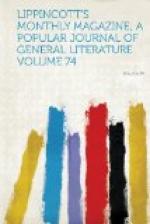* * * * *
The project to turn the famous palace of Madrid into a museum like that of Versailles inspires Angel de Miranda to recall the strange vicissitudes of government which the vast, majestic edifice has witnessed—it and its predecessor on the same site—during seven centuries. Situated in the western quarter of the city, its principal face dominates a grand esplanade called the “Field of the Moor,” after the Moorish camp there established in the twelfth century. A fortress first, the original structure was turned by Peter the Cruel, a lover of fine architecture, into a royal castle, or alcazar, as it was then called, the word being borrowed from the Arabic. It became thenceforth an historic spot of Spain. It was the prison of Francis I. after Pavia. It was the dwelling of Philip II., who first made it the official royal residence; and there died his son, Don Carlos, whose tragic career has inspired so much dramatic literature, from Schiller’s fierce handling of Philip II. to the widely different treatment of the subject by Don Gaspar Nunez de l’Arce in his drama played for the first time the past year. In the same palace, continues Miranda, died Elizabeth of Valois. There Philip IV. had farces played by ordinary comedians while the tragedy of his own downfall was enacting without. A fire reduced to ashes the haughty Alcazar at the moment when the Austrian dynasty disappeared from the realm, and on its ruins Philip V., first of the Spanish Bourbons, built the sumptuous palace that exists today. Stranger tenants even than its predecessor’s it was fated to see—Riperda, Farinelli, Godoy, who began his political rise by his skill with the guitar; and Joseph Bonaparte, to whom his fraternal patron said, “Brother, you will have better lodgings now than mine.” There Ferdinand VII. passed his life in breaking his word, and there reigned Isabella II., first adored, then execrated. Marshal Serrano established there his modest headquarters as regent of a provisory kingdom, and there lived Amadeo, who had the spirit to quit a throne which he could not occupy with dignity. What a story of changed times and manners does it tell, when, in a detached wing of this royal edifice, we find installed Don Emilio Castelar, foreign minister of the Spanish republic!




